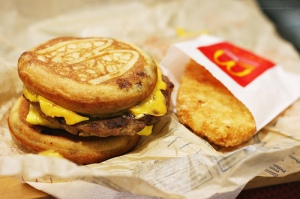Yesterday McDonald’s took the bold move in announcing the availability of breakfast all day across their 14,300+ North American locations, starting on October 6th. Click here for the press release. Now patrons will be able to order hash browns with their McRib sandwiches or get a tasty McGriddle for dinner…all those calories and saturated fats are sure to help anyone fall asleep faster. By some estimates this move could increase the breakfast goods sales by 4%. It is also a reaction to customer demand as well as an attempt also to reinvigorate the fast food giant who has been slumping as of late.
With the hamburger market shifting towards more fast casual offerings such as Five Guys, Whataburger, Shake Shack and In-N-Out Burger. As well as facing competitors focused on just selling chicken related fast food, such as Chick-fil-A, and the fact that Mexican and Asian based fast foods are outpacing the burger chain – McDonalds has to figure out how to turn the tide. While time will tell how the customers and the market reacts to this move, there are some lessons to be drawn from it:
- The empowered consumer strikes again. One of the major shifts we have seen with the digital economy is the increased power in the voice of the consumer. The customer has a voice – social, they have the reach – mobile, greater choice – the internet and thanks to folks like Amazon, have high expectations with regards to product variation. Consumers are no longer willing to accept a limited number of choices, rather they have been trained to expect and demand a large array of choice. With regards to the food industry this is no exception. Consumers don’t accept being limited by arbitrary time limitations on menu items or even not being able to customize their orders. All one has to do is listen to the orders that are throw about in Starbucks – grande skinny vanilla latte with an extra shot or venti soy latte with extra foam…it seems at times the options are endless. Consumers have been trained, in part by the likes of Amazon and Alibaba, to expect a high degree of choice. And by the likes of Dell to expect greater control in customization. The genie is out of that bottle, it will be up to retailers and consumer facing businesses to react accordingly.
- Supply chains get none of the glory but all of the work. It is easy for consumers to expect companies like McDonalds to “flip” a switch and add breakfast items to the all day menu. Consumers at times can grow frustrated as they see a lack of action on something that appears so “simple” to the outside. The reality is the supply chains are the ones that have to keep up, and that is not a simple endeavor. McDonalds will now have to rethink their replenishment and inventory strategies – ensure that they increase their stock of breakfast foods so sustain all day demand. McDonalds and their franchises will have to keep a eye on how their demand patterns shift as well. When they offered specific menus at set times, they could at least contain demand patterns to specific times. Starting in early October demand patterns could be turned upside down. It will be crucial for McDonalds to quickly understand how these shifts will impact their distribution models within the supply chain.
- Don’t forget the process changes to your supply chain. How about the manufacturing process, aka cooking? Each McDonalds kitchen is optimized to be able to cook breakfast and lunch/dinner using the same machines, but not at the same time. Stores will have to determine how to cook egg based products at the same time as hamburgers. Oh and you have to ensure raw eggs don’t come into contact with other food products. By some estimates it will cost individual stores up to $5000 to re-kit some of their kitchens to meet these new processes. Not a huge sum when you consider McDonalds corporate, but not a trivial amount at the franchise level. This will also change the business processes within the stores. Staff will be asked to mix and match breakfast and lunch/dinner items. New processes will have to be implemented and training will have to accompany those processes.
- Will this be successful? These types of strategic moves can, at times, appear simple and “no brainers” but the reality hits when the numbers are digested. McDonalds must ensure they have a keen eye on the metrics. Does this drive increased in store sales? Does it provide a lift for breakfast items? How does it measure up with other McDoanalds’ products? Are there complimentary relationships that emerge? Do Big Macs paired with hash browns become a big selling item? What is the impact on margin? I am sure that McDonalds has done some extensive testing and model building to make this move, but as with all plans, most rarely survive first contact with the consumer. McDonalds must have the systems in place to monitor and measure how this impacts the financials.
McDonalds’ breakfast all day…smells like a winner. Well at least for the consumer. Question is, like with any NPI (new product introduction), can the underlying supply chain sustain success and has the new offering addressed a need that was otherwise unmet? Only time will tell. But some valuable lessons non the less.
Hmmmm, maybe I will go get an Egg McMuffin and a 6 piece Chicken McNugget for dinner…



